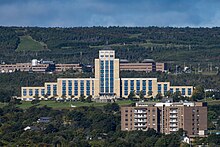Newfoundland and Labrador House of Assembly
Newfoundland and Labrador House of Assembly | |
|---|---|
| 50th General Assembly of Newfoundland and Labrador | |
 | |
| Type | |
| Type | Lower house (1832–1934) then unicameral house of the General Assembly of Newfoundland and Labrador |
| History | |
| Founded | 1832 |
| Leadership | |
Government House Leader | |
Opposition House Leader | |
| Structure | |
| Seats | 40 |
 | |
Political groups | Government
Official Opposition Others
|
| Elections | |
Last election | March 25, 2021 |
Next election | On or before November 24, 2025 |
| Meeting place | |
 | |
| Colonial Building (1850–1959) Confederation Building (1959–present) | |
| Website | |
| www | |
The Newfoundland and Labrador House of Assembly (French: Chambre d'assemblée de Terre-Neuve-et-Labrador) is the unicameral deliberative assembly of the General Assembly of Newfoundland and Labrador of the province of Newfoundland and Labrador, Canada.[1] It meets in the Confederation Building in St. John's. Bills passed by the assembly are given royal assent by the lieutenant governor of Newfoundland and Labrador, in the name of the King of Canada.[2]
The governing party sits on the left side of the speaker of the House of Assembly as opposed to the traditional right side of the speaker. This tradition dates back to the 1850s as the heaters in the Colonial Building were located on the left side. Thus, the government chose to sit near the heat, and leave the opposition sitting in the cold.[3]
Homes of Legislature
Before 1850 the legislature has sat at various locations including Mary Travers' tavern on Duckworth Street across from War Memorial 1832, St. John's Court House (at Duckworth and Church Hill) from 1833 to 1846, a building on southwest corner of Water Street and Prescott Street (since replaced with office building) and the site of the former St. Patrick’s Hall on Queen’s Road and Garrison Hill (demolished and replace by current building 1880[4]).
Permanent homes of the legislature, Confederation Building and Colonial Building, are the only surviving structures.[5][6]
Constituencies
Members represent one electoral district each. There are 40 seats in the House of Assembly.[7]
Seating plan
Current members (MHAs)


Party leaders' names are written in bold and cabinet ministers in italic, with the Speaker of the House of Assembly designated by a dagger (†).
Seat total and official layout
| Party | Leader | Seats | ||
|---|---|---|---|---|
| March 25, 2021 | Current | |||
| Liberal | Andrew Furey | 22 | 22 | |
| Progressive Conservative | Tony Wakeham | 13 | 14 | |
| New Democratic | Jim Dinn | 2 | 2 | |
| Independent | N/A | 3 | 2 | |
| Vacant | N/A | 0 | 0 | |
| Members | 40 | 40 | ||
See also
- 50th General Assembly of Newfoundland and Labrador
- 48th General Assembly of Newfoundland and Labrador
- 47th General Assembly of Newfoundland and Labrador
- Speaker of the House of Assembly of Newfoundland and Labrador
- List of Newfoundland and Labrador General Assemblies
References
- ^ Maher, David. "You could say the Newfoundland and Labrador House of Assembly is in its 'infant' stage | The Chronicle Herald". www.thechronicleherald.ca. Retrieved December 17, 2020.
- ^ Newfoundland Act, 12-13 Geo. VI [1949], c. 22 (U.K.), Sch. 1 (Terms of Union) s. 14
- ^ O'Neill, Paul (2003). The Oldest City: The Story of St. John's, Newfoundland. St. Philip's, NL: Boulder Publications. p. 336. ISBN 9781459301238.
- ^ "History – Benevolent Irish Society". Archived from the original on August 11, 2020.
- ^ "October 2013".
- ^ "Newfoundland's historic Colonial Building to undergo restoration – Daily Commercial News". Archived from the original on December 15, 2013. Retrieved December 15, 2013.
- ^ "Full list of winners in Newfoundland and Labrador election". CBC News, November 30, 2015.
